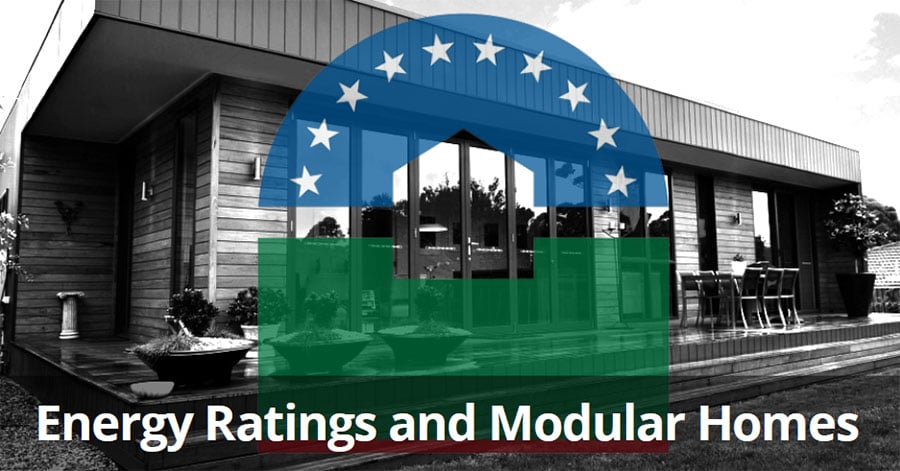 Energy ratings are one of those things that everybody’s heard of but which most people don’t know a lot about.
Energy ratings are one of those things that everybody’s heard of but which most people don’t know a lot about.
In his article, we’ll give a “need to know” summary of what energy ratings are and how they work, and in particular we’ll look at how energy ratings affect modular home building.
What is an energy rating?
An energy rating is a rating given to a building that indicates how energy efficient the building is.
The more energy efficient the building, the higher the rating.
The rating system works on a star basis, so 1 star would be the lowest rating, with 10 stars being the highest.
A simple way to look at energy ratings is that if a home has a 10-star energy rating, it would not require any heating and cooling at all because it would be so well designed and constructed that it would be capable of maintaining a comfortable temperature inside at all times.
Why do energy ratings matter?
Energy ratings are important for two main reasons:
-
In order to be granted a permit to build a new home (and for some major renovations) you’ll need at least a 6-star rating. It’s important to note that from May 1st 2024, there will be an increase in the minimum energy efficiency standards for new Australian homes, from 6-stars to 7-stars.
-
The higher your energy star rating, the more money you’ll save on heating and cooling bills, so it’s in your interest to invest in the highest rating possible in order to future proof your home and to save money over the life of your home.
What factors influence your energy rating?
According to Choice, 38% of home energy use comes from heating and cooling, so it makes sense that thermal factors are going to play the biggest part in your home’s energy rating.
The main factors that influence your energy rating are:
-
Building orientation and internal zoning
-
Insulation levels
-
Thermal mass and shading
-
Windows’ thermal performance, sizing andlocation
-
Weather stripping, sealing the building envelope
-
Energy efficient lighting.
There is no one major factor in deciding on your energy rating, but rather it’s a combination of how all these things work together.
Who decides on your energy rating?
The rating system operates on a state by state basis, however it is very similar from state to state. Each state government has an approved list of energy raters who are qualified to provide ratings.
For example, in Victoria you can find a list of approved raters on the Sustainability Victoria website.It is up to your home builder and/or designer to organise your energy rating as part of the approval process in organising building permits.
Energy raters use the information available at the design stage of building a home to give the home an energy rating. If the home doesn’t meet the 6-star minimum requirement first time round, they’ll usually provide recommendations on how the designer and/or builder can improve the rating.
How do modular homes rate?
The truth is that modular homes by default are neither more nor less energy efficient than a traditional home. What does make a difference is the quality of design.
We chatted with Michael Guler from Rate Energy (the energy rating consultants we use here at Anchor Homes) about how modular homes stack up when it comes to energy ratings, and what people building a modular home need to keep in mind:
“Most modular homes I’ve seen are designed very well. Lots of light comes in, which is important for passive heating, and the materials used in most modular builds are extremely energy efficient.”
Michael goes on to point out “we have no trouble achieving a 6-star rating with Anchor’s modular designs, and in many cases it would be easy for their designs to achieve a 7 or 8 star rating. Anchor’s modular designs are more energy efficient than the specifications we typically see from high volume builders.”
Michael advises that a good builder will be thinking carefully about the energy rating during the design stage, as this makes it easier to ensure the minimum 6-star rating is achieved without having to go back to the drawing board at a later stage of the process.
Tips for improving your energy rating and efficiency
Choice recommends the following steps as the simplest ways to improve your home’s energy efficiency:
-
Insulate well – even a well-insulated roof alone can save you up to 45% on heating and cooling, so high quality insulation plays a major part.
-
Consider shade – shading can block up to 90% of the heat absorbed by sunlight, so consider shading either from natural structures or man-made structures such as shade cloth.
-
Draughts – sealing drafts around your home can save a whopping25% off your power bill. Choice recommends installing fans and vents that close automatically, and sealing doorways with a draught stopper at the base of the frame.
For more information about energy ratings and energy saving you can visit the government website http://yourenergysavings.gov.au/.
Do you have questions or comments about the energy rating system, or ways to make your home more energy efficient? Leave a comment below.
